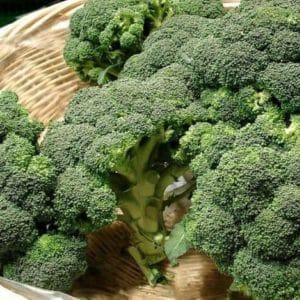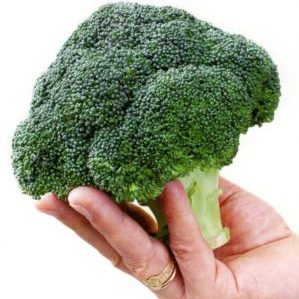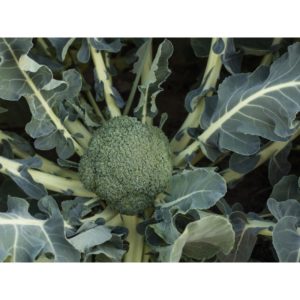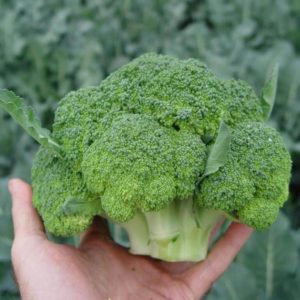Broccoli hybrid Batavia F1
Broccoli belongs to the category of the healthiest vegetables in the human diet, but at the same time it is distinguished by difficult agricultural techniques for growing. The optimal solution for private summer residents and large farmers has become cultivation hybrids from the world's leading breeders. One of the best options for a garden and garden is Batavia F1.
Description of broccoli Batavia F1

The hybrid is highly productive and is grown as through seedlings, and through sowing seeds in the ground.
Forms small elastic heads of compact shape weighing up to 1 kg.
The heads are round with an intense dark green color. The structure of the inflorescences is fine-grained. Suitable for sale fresh and frozen.
Characteristics
The Batavia hybrid is characterized by:
- frost resistance and early ripening;
- high degree of drought resistance;
- excellent taste;
- excellent keeping quality and transportability;
The ripening period of the hybrid is 65–68 days. The average yield is 2.5–2.7 kg/m2.
Advantages and disadvantages

Batavia broccoli is adapted to the most difficult conditions growing.
During the season, from one plot, subject to staged planting, the crop is harvested up to 3-4 times. Vegetables have a harmonious and rich taste, there is no bitterness.
Batavia is resistant to fusarium and other fungal diseases. High-density heads are formed from inflorescences in any conditions, even during prolonged periods of heat. The crop tolerates transportation well over long distances.
Compared to such mid- and late-ripening crops as Linda and Monaco, Batavia loses in yield by 35–40% and has a coarser inflorescence structure.
Landing
The optimal temperature for broccoli development is +16…+25°C. Hybrid seeds do not need preparation for planting, but soaking in a growth stimulator such as Epin or Gumat stimulates uniform germination. The swollen seeds are sown in containers to a depth of 1 cm with a row spacing of 3 cm.
The seedlings are transferred to open ground 30–40 days after germination. Optimal timing by region:
- southern - early to mid-March;
- central - late March-early April;
- northern - mid-to-late April.
The last time to plant broccoli is the beginning of July, provided that drip irrigation is organized on the site. In this case, the fruits are obtained in late September-early October.
On a note! Broccoli does not tolerate pickling, so experienced farmers sow it in individual peat pots.
Broccoli is planted in an area that is as open as possible but protected from the wind. Suitable predecessors are cucumbers, mustard, tomatoes, peas, carrots. The optimal planting pattern is 30 cm between plants with a row spacing of 50–55 cm.
Growing and care
Broccoli is a tough crop and produces good yields from quality seeds, but requires some attention.
Watering
The crop does not tolerate heat well: in such conditions the inflorescences turn yellow, the heads become loose and unsuitable for food. The optimal watering regime is once every 6-7 days, in the evening or early morning. When the heat sets in above +25...+26°C, the frequency of irrigation is increased to 4-5 times a week.
Attention! In regions with heavy clay soils, the heads are additionally moistened.
Fertilizer
Broccoli must be fed according to the following scheme:
- On days 13–15 after planting in the ground - a solution of mullein or chicken manure (250 g per 10 liters of water, consumption rate - 1 liter per m2).
- 35–40 days after planting in the ground - with a solution of nitrate (1 matchbox per bucket of water).
- After cutting the central head, apply 1 liter of the mixture under each bush. To do this, dilute 10 g of ammonium nitrate, 20 g of superphosphate and 30 g of potassium sulfate in 10 liters of water.
10–12 days before the final harvest, wood ash is scattered over the area (1 tbsp per 1 m2).
Prevention and protection from diseases and pests
 Batavia is highly resistant to fusarium and does not require constant spraying of the beds.
Batavia is highly resistant to fusarium and does not require constant spraying of the beds.
It is important to remember that fungal diseases spread through spores that successfully overwinter on weeds in the ground in winter.
To prevent putrefactive diseases, the area is thoroughly cleaned of plant debris and dug up.
Advice! In heavily polluted beds, after harvesting the predecessor, vegetating rhizomatous and root shoot weeds are treated with the Roundup herbicide at a dose of 4 l/ha.
Insects cause much more damage to such plantings. Broccoli is most attacked by:
- cruciferous flea beetle - “Cypermethrin” helps;
- aphids - use Iskra-Bio or Actellik;
- cabbage fly - plants are irrigated with “Aktellik” or “Foxim”;
- cabbage scoop - sprayed with “Ambush”, “Belofos”, “Rovikurt”.
Spraying red hot pepper between the rows of cabbage helps fight massive plant infestation by aphids and cabbage cutworm.
Covering broccoli with lutrasil during the summer of cabbage cutworm butterflies reliably protects the crop from insects.
Reviews from vegetable growers
Many summer residents have tried the Batavia hybrid and are familiar with its advantages and disadvantages in practice:
Ivan, Krasnodar: “I grow broccoli in 3-4 stages and continuously collect inflorescences throughout the season. I get my last harvest in early October and use for freezing. I disassemble the heads and pack them in bags - they stay in the freezer perfectly until spring. Batavia F1 is less susceptible to pests compared to other varieties.”
Margarita, Rostov-on-Don: “I am engaged in growing organic vegetables and fruits on my own plot. The Batavia F1 hybrid was recommended by the guys in my Instagram community on healthy lifestyle. Broccoli takes up a lot of space, so I plant it next to cauliflower and Brussels sprouts - there has never been a mass infestation of pests, the inflorescences are dense. The heads are good for baking and purees, but they are still a bit rough in salads.”
Marina, Tolyatti: “I’ve never been involved in vegetable growing, but after moving to the private sector I became interested in gardening. I only planted traditional vegetables, but this year I decided to take a risk and planted broccoli. I bought the seeds on the Internet, the manager recommended the Batavia hybrid, the price was affordable - I agreed. All the seeds sprouted from the bag, but I waited and sprouts stretched out a little. I had to look after it for a long time, but I got cabbage from the plot. The heads of cabbage are small, 700–800 g, but green. Next year I want to correct the mistake and grow the same hybrid, but I will approach the matter responsibly. I want heads up to 1.5 kg, as the seller said.”
Conclusion
The Batavia hybrid is characterized by increased resistance to prolonged dry periods; the inflorescences do not crack or turn yellow in direct sunlight.If you follow the rules of agricultural technology, cabbage produces 3-4 full-fledged harvests per season and is well suited for cultivation by beginning gardeners.